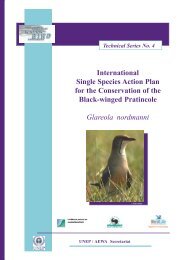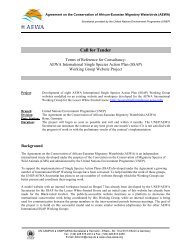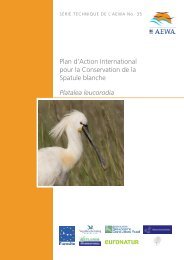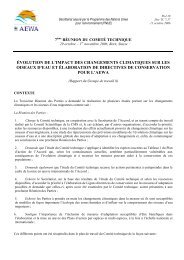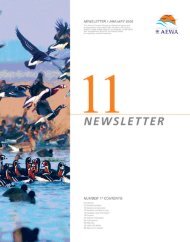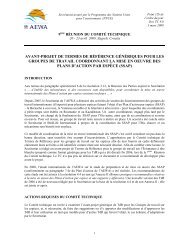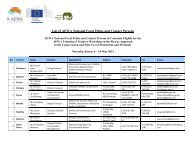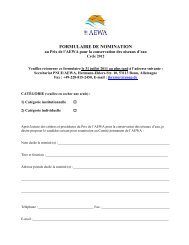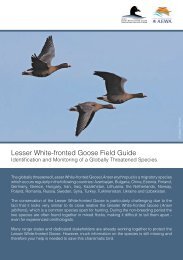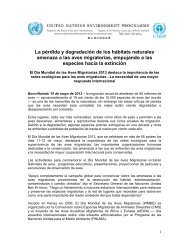International Single Species Action Plan for the ... - AEWA
International Single Species Action Plan for the ... - AEWA
International Single Species Action Plan for the ... - AEWA
You also want an ePaper? Increase the reach of your titles
YUMPU automatically turns print PDFs into web optimized ePapers that Google loves.
<strong>AEWA</strong> Technical Series No. 36 - Annexes<br />
Formerly bred in large numbers, but wild population now thought to be extinct and <strong>the</strong>re have<br />
been no breeding records during <strong>the</strong> last 10 years. However, <strong>the</strong> historical spring flyway was<br />
probably from Finland across <strong>the</strong> Baltic Sea/ Bay of Bothnia and along <strong>the</strong> Swedish coastline.<br />
There were important staging areas at some places along <strong>the</strong> coast in nor<strong>the</strong>rn Sweden and <strong>the</strong><br />
flyways <strong>the</strong>n followed <strong>the</strong> river valleys into <strong>the</strong> country’s interior and <strong>the</strong> breeding areas in<br />
<strong>the</strong> mountains (fjällen). There are still occasional observations of Lesser Whitefronts along<br />
<strong>the</strong> nor<strong>the</strong>rn Swedish coastline and along <strong>the</strong> rivers of nor<strong>the</strong>rnmost Sweden, as shown by<br />
spring/summer records of five individuals in Norbotten county in 2005. These birds almost<br />
certainly originate from <strong>the</strong> Fennoscandian population and not from <strong>the</strong><br />
supplemented/reintroduced population, though, as yet, <strong>the</strong>re are no studies to confirm this.<br />
The supplemented/reintroduced birds use more sou<strong>the</strong>rly flyways in Sweden. The possibility<br />
that a few pairs from <strong>the</strong> wild Fennoscandian population still breed in Sweden cannot be<br />
excluded (M. Björkland, pers comm).<br />
Since 1977 a captive-breeding and supplementation/reintroduction programme has resulted in<br />
<strong>the</strong> establishment of a free-flying population in Swedish Lapland. These birds migrate to The<br />
Ne<strong>the</strong>rlands, following <strong>the</strong> flyway of Barnacle Goose (Branta leucopsis) foster parents. The<br />
supplemented/reintroduced population stages on <strong>the</strong> Swedish coast of <strong>the</strong> Gulf of Bothnia and<br />
at additional inland areas in sou<strong>the</strong>rn Sweden. Å. Andersson estimates <strong>the</strong> current size of <strong>the</strong><br />
supplemented/reintroduced population at 80-100 birds with 15 breeding pairs (Å. Andersson,<br />
pers. comm.). No releases of birds into <strong>the</strong> wild have been made since 1999, following <strong>the</strong><br />
discovery of introgressed genes of Greater White-fronted Goose (Anser albifrons) among <strong>the</strong><br />
captive stock (Å. Andersson, 2004).<br />
The Swedish Environmental Protection Agency considers that observations of one Lesser<br />
White-fronted Goose with four young (1979), and of ten Lesser White-fronts without rings<br />
(1982) in Lapland (Å Andersson, unpubl. data) could indicate a possibility that a nesting pair<br />
of wild origin had remained be<strong>for</strong>e <strong>the</strong> supplementations/reintroductions started in 1981.<br />
Syria<br />
Vernacular name: Al-Owaza Alramadeya, or Al-Owaza Al Garaa Al Saghera<br />
الأوزة الرمادية /<br />
الأوزة الغراء الصغيرة<br />
Vagrant, with three records up to 1995.<br />
Following <strong>the</strong> discovery of a Russian satellite-tagged Lesser White-fronted Goose wintering<br />
in eastern Syria, an expedition to <strong>the</strong> region was organised in February 2007 with <strong>the</strong> aim of<br />
visiting and researching three poorly known sites very close to <strong>the</strong> Iraq border. Un<strong>for</strong>tunately,<br />
<strong>the</strong> satellite-tagged bird departed <strong>for</strong> Iraq just prior to <strong>the</strong> expedition, but many significant<br />
findings were made never<strong>the</strong>less. The highlight was <strong>the</strong> discovery of at least eight, and<br />
probably many more, Lesser White-fronts, suggesting that Syria may be an important<br />
wintering area <strong>for</strong> <strong>the</strong> Western main population (http://www.piskulka.net/Satellite<br />
tracking.htm). Fur<strong>the</strong>r research is required to build on <strong>the</strong>se observations and describe <strong>the</strong><br />
situation of <strong>the</strong> species in Syria.<br />
Turkey<br />
Vernacular name: Küçük sakarca<br />
Rare winter visitor, occurring regularly in European Turkey in very small numbers, notably at<br />
Saros Körfezi (=‘Saros bay’, recognised by BirdLife <strong>International</strong> as an Important Bird Area,<br />
ref. TR101). It is thought that some birds are overlooked owing to poor ornithological<br />
coverage of this part of <strong>the</strong> country and it is likely that <strong>the</strong> actual distribution of occurrences is<br />
wider than presently known.<br />
<strong>International</strong> <strong>Single</strong> <strong>Species</strong> <strong>Action</strong> <strong>Plan</strong> Lesser White-fronted Goose –Annexes<br />
XVI



